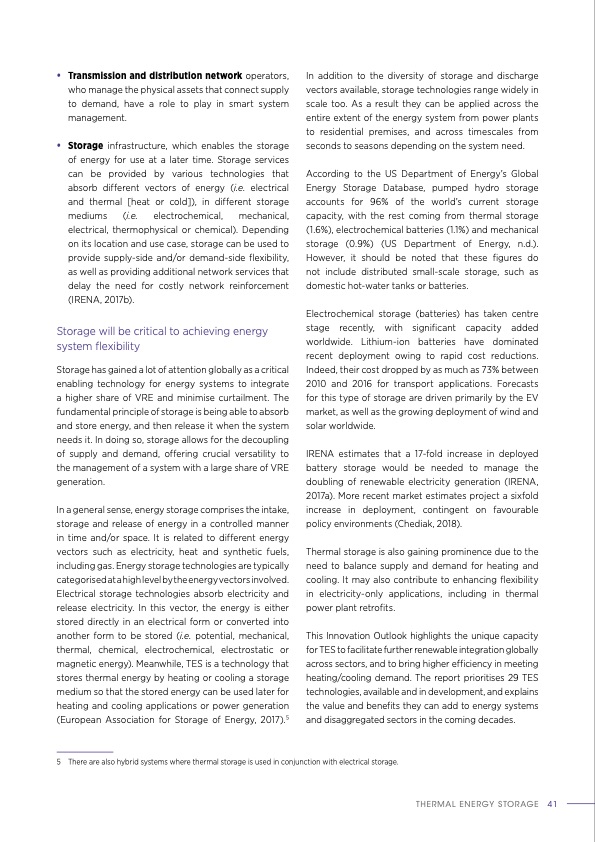
PDF Publication Title:
Text from PDF Page: 041
• Transmission and distribution network operators, who manage the physical assets that connect supply to demand, have a role to play in smart system management. • Storage infrastructure, which enables the storage of energy for use at a later time. Storage services can be provided by various technologies that absorb different vectors of energy (i.e. electrical and thermal [heat or cold]), in different storage mediums (i.e. electrochemical, mechanical, electrical, thermophysical or chemical). Depending on its location and use case, storage can be used to provide supply-side and/or demand-side flexibility, as well as providing additional network services that delay the need for costly network reinforcement (IRENA, 2017b). Storage will be critical to achieving energy system flexibility Storage has gained a lot of attention globally as a critical enabling technology for energy systems to integrate a higher share of VRE and minimise curtailment. The fundamental principle of storage is being able to absorb and store energy, and then release it when the system needs it. In doing so, storage allows for the decoupling of supply and demand, offering crucial versatility to the management of a system with a large share of VRE generation. In a general sense, energy storage comprises the intake, storage and release of energy in a controlled manner in time and/or space. It is related to different energy vectors such as electricity, heat and synthetic fuels, including gas. Energy storage technologies are typically categorised at a high level by the energy vectors involved. Electrical storage technologies absorb electricity and release electricity. In this vector, the energy is either stored directly in an electrical form or converted into another form to be stored (i.e. potential, mechanical, thermal, chemical, electrochemical, electrostatic or magnetic energy). Meanwhile, TES is a technology that stores thermal energy by heating or cooling a storage medium so that the stored energy can be used later for heating and cooling applications or power generation (European Association for Storage of Energy, 2017).5 In addition to the diversity of storage and discharge vectors available, storage technologies range widely in scale too. As a result they can be applied across the entire extent of the energy system from power plants to residential premises, and across timescales from seconds to seasons depending on the system need. According to the US Department of Energy’s Global Energy Storage Database, pumped hydro storage accounts for 96% of the world’s current storage capacity, with the rest coming from thermal storage (1.6%), electrochemical batteries (1.1%) and mechanical storage (0.9%) (US Department of Energy, n.d.). However, it should be noted that these figures do not include distributed small-scale storage, such as domestic hot-water tanks or batteries. Electrochemical storage (batteries) has taken centre stage recently, with significant capacity added worldwide. Lithium-ion batteries have dominated recent deployment owing to rapid cost reductions. Indeed, their cost dropped by as much as 73% between 2010 and 2016 for transport applications. Forecasts for this type of storage are driven primarily by the EV market, as well as the growing deployment of wind and solar worldwide. IRENA estimates that a 17-fold increase in deployed battery storage would be needed to manage the doubling of renewable electricity generation (IRENA, 2017a). More recent market estimates project a sixfold increase in deployment, contingent on favourable policy environments (Chediak, 2018). Thermal storage is also gaining prominence due to the need to balance supply and demand for heating and cooling. It may also contribute to enhancing flexibility in electricity-only applications, including in thermal power plant retrofits. This Innovation Outlook highlights the unique capacity for TES to facilitate further renewable integration globally across sectors, and to bring higher efficiency in meeting heating/cooling demand. The report prioritises 29 TES technologies, available and in development, and explains the value and benefits they can add to energy systems and disaggregated sectors in the coming decades. 5 There are also hybrid systems where thermal storage is used in conjunction with electrical storage. THERMAL ENERGY STORAGE 41PDF Image | THERMAL ENERGY STORAGE Outlook

PDF Search Title:
THERMAL ENERGY STORAGE OutlookOriginal File Name Searched:
IRENA_Innovation_Outlook_TES_2020.pdfDIY PDF Search: Google It | Yahoo | Bing
Turbine and System Plans CAD CAM: Special for this month, any plans are $10,000 for complete Cad/Cam blueprints. License is for one build. Try before you buy a production license. More Info
Waste Heat Power Technology: Organic Rankine Cycle uses waste heat to make electricity, shaft horsepower and cooling. More Info
All Turbine and System Products: Infinity Turbine ORD systems, turbine generator sets, build plans and more to use your waste heat from 30C to 100C. More Info
CO2 Phase Change Demonstrator: CO2 goes supercritical at 30 C. This is a experimental platform which you can use to demonstrate phase change with low heat. Includes integration area for small CO2 turbine, static generator, and more. This can also be used for a GTL Gas to Liquids experimental platform. More Info
Introducing the Infinity Turbine Products Infinity Turbine develops and builds systems for making power from waste heat. It also is working on innovative strategies for storing, making, and deploying energy. More Info
Need Strategy? Use our Consulting and analyst services Infinity Turbine LLC is pleased to announce its consulting and analyst services. We have worked in the renewable energy industry as a researcher, developing sales and markets, along with may inventions and innovations. More Info
Made in USA with Global Energy Millennial Web Engine These pages were made with the Global Energy Web PDF Engine using Filemaker (Claris) software.
Sand Battery Sand and Paraffin for TES Thermo Energy Storage More Info
| CONTACT TEL: 608-238-6001 Email: greg@infinityturbine.com | RSS | AMP |